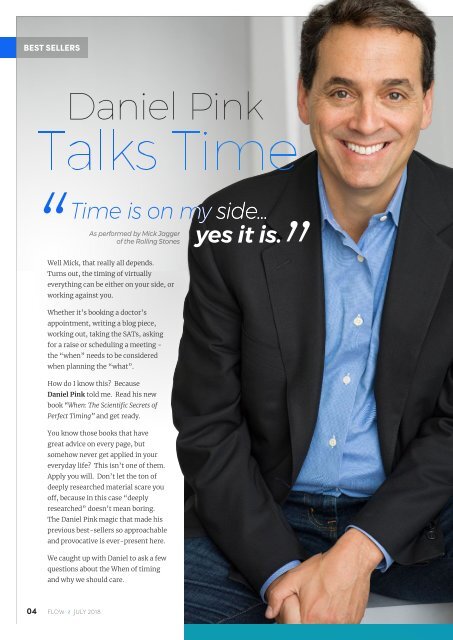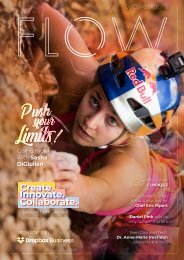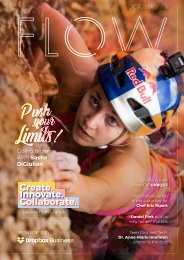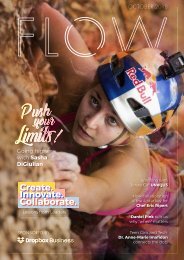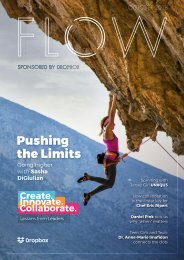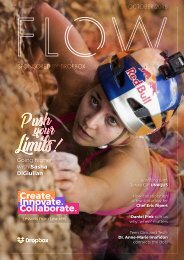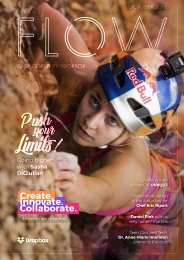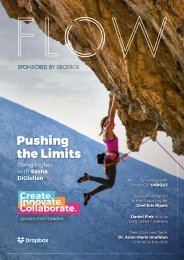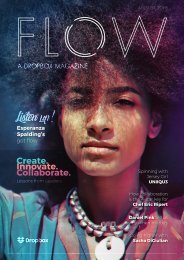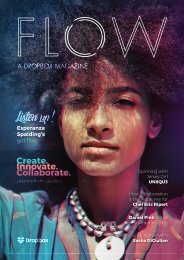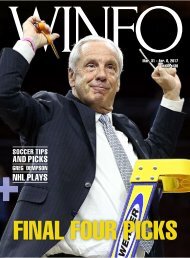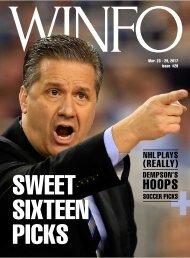wrc-db-prototype-02
You also want an ePaper? Increase the reach of your titles
YUMPU automatically turns print PDFs into web optimized ePapers that Google loves.
BEST SELLERS<br />
Daniel Pink<br />
Time is on my side...<br />
As performed by Mick Jagger<br />
of the Rolling Stones yes it is.<br />
Well Mick, that really all depends.<br />
Turns out, the timing of virtually<br />
everything can be either on your side, or<br />
working against you.<br />
Whether it’s booking a doctor’s<br />
appointment, writing a blog piece,<br />
working out, taking the SATs, asking<br />
for a raise or scheduling a meeting -<br />
the “when” needs to be considered<br />
when planning the “what”.<br />
How do I know this? Because<br />
Daniel Pink told me. Read his new<br />
book “When: The Scientific Secrets of<br />
Perfect Timing” and get ready.<br />
You know those books that have<br />
great advice on every page, but<br />
somehow never get applied in your<br />
everyday life? This isn’t one of them.<br />
Apply you will. Don’t let the ton of<br />
deeply researched material scare you<br />
off, because in this case “deeply<br />
researched” doesn’t mean boring.<br />
The Daniel Pink magic that made his<br />
previous best-sellers so approachable<br />
and provocative is ever-present here.<br />
We caught up with Daniel to ask a few<br />
questions about the When of timing<br />
and why we should care.<br />
04 FLOW JULY 2018<br />
~
“FLOW”<br />
PROTOYPE REV 1.7
DAY-TO-DAY WHEN<br />
Q: About 30 pages into When, a mounting sense<br />
of lost opportunity waved over me as I realized<br />
I've been doing it wrong all these years (damn<br />
you, late afternoon meetings with Finance!).<br />
This may well be one of the best books on<br />
optimization I've read in years (and I've read a<br />
lot of them). There are practical, executable<br />
tips throughout.<br />
With that in mind, how has your work routine<br />
changed post-research compared to<br />
pre-research for the book, if at all?<br />
Daniel: It’s changed may own routines in several<br />
ways. Let me offer two.<br />
First, once I began understanding the research<br />
on peaks, troughs, and recoveries, I reorganized<br />
my day. Since I’m a more of a lark than an owl,<br />
my peak is the morning. That’s when I’m best<br />
doing analytic work - like conjuring words and<br />
trying to make them march in formation. So<br />
early in the writing of the book, I took a new<br />
approach. Every morning, I came into my office<br />
- the garage behind my house - around 830. I<br />
gave myself a word count - usually around 700<br />
or 800 words. And I didn't do anything else until<br />
I wrote the required number of words. No<br />
checking email. No watching sports highlights.<br />
Nothing. I didn’t even bring my phone into the<br />
office. By doing that every day - 700 words<br />
today, 800 words the next<br />
day, another 800 the day after<br />
that - the pages begin piling<br />
up. And, believe it or not, this<br />
book on timing was the first<br />
book I ever delivered on time!<br />
Second, I’ve become more<br />
systematic about taking<br />
breaks. Each day, on my list of<br />
things to do, I try to schedule<br />
at least one afternoon break.<br />
And those breaks almost<br />
always abide by the design<br />
principles that science tells us<br />
make breaks most effective -<br />
moving, outside, social, and<br />
fully detached. So in the<br />
afternoon, you might see me<br />
walking around my neighborhood - often with<br />
my wife, but never with my phone. I used to<br />
think that amateurs take breaks and<br />
professionals don’t. Now I understand that the<br />
truth is the opposite: Professionals take breaks.<br />
It’s the amateurs who ignore breaks.<br />
COLLABORATION WHEN<br />
DQ: aniel, as I mentioned, this book has<br />
optimization tips throughout. If you and I had<br />
the opportunity to walk the National Mall for<br />
30 minutes chatting about When and its<br />
relationship to the collaborative process,<br />
what's one actionable tip I would take away?<br />
Daniel: I’d ask us to spend 15 of those minutes<br />
talking not about how to collaborate more<br />
effectively and instead talking about why we’re<br />
collaborating in the first place. What are we<br />
trying to accomplish? Why are we doing this in<br />
the first place? What’s the point of the exercise?<br />
Then I’d schedule a separate time for a<br />
pre-mortem. In this technique, created by<br />
psychologist Gary Klein, we look out, say, one<br />
year from now and imagine that our shared<br />
project is a bust. Then we try to figure out what<br />
went wrong. And then, returning to the present<br />
day, we set up ways to avoid those pitfalls. I’d<br />
much rather make mistakes in my head in<br />
advance than in real time on a real project.<br />
SINGING WHEN<br />
Q: When has received a lot of press and reviews<br />
since it came out and landed on the best-seller<br />
list. Is there anything in the book that you<br />
thought would receive more attention, but<br />
hasn’t?<br />
Daniel: I thought the material on choral singing<br />
- the fact that it’s basically as good for us as<br />
physical exercise - would have gotten more<br />
attention. That said, there’s still, er, time!<br />
Looking for more from Daniel? Check out his<br />
fantastic Ted Talk on motivation below or visit<br />
DanPink.com to connect with him on social media<br />
and read more about When and his five other books,<br />
including other New York Times bestsellers A Whole<br />
New Mind, Drive and To Sell is Human.<br />
The Puzzle<br />
of Motivation<br />
Dan Pink<br />
<br />
~<br />
<br />
05
COLLABORATORS<br />
in the kitchen<br />
Collaboration<br />
&<br />
Q A<br />
with Chef Eric Ripert<br />
My Dad held up his glass to mine and proclaimed<br />
“to easily one of the best meals I’ve ever had”.<br />
~~~~~~~~~<br />
Perhaps predictable when dining at Le Bernardin, the revered<br />
Michelin three-star restaurant in New York, but to this day that<br />
experience (a treat from my Dad on our first trip to New York back<br />
in 2014) stands out as a truly memorable culinary event for both<br />
of us.<br />
The evening was a study in collaboration and creativity.<br />
From the first step in the door the team produced a<br />
seamless flow of exceptional hospitality, ambience,<br />
service and food.<br />
As the chef and co-owner of Le Bernardin, Eric Ripert’s<br />
part in this orchestra of teamwork is not insignificant.<br />
We caught up with Chef Ripert to talk creativity,<br />
collaboration and a surprising new option that<br />
needed both to make the menu.<br />
Q: Chef Ripert, can you talk the collaborative<br />
process at Le Bernardin? And the evolution, if<br />
any, in how you approach collaborating today<br />
vs. when you first began your career?<br />
Chef: Teamwork at Le Bernardin is everything.<br />
Whether creatively collaborating on a new<br />
dish or ensuring an evening in the dining<br />
room runs smoothly, our employees are our<br />
family and must all work together with<br />
respect and harmony. We have an<br />
unbelievably loyal team - many of the<br />
members have been with us for more than<br />
20 years! We have a warm relationship and<br />
overwhelming dedication that makes it<br />
easy for them to understand and share our<br />
vision with every guest who joins us at Le<br />
Bernardin.<br />
06 FLOW JULY 2018<br />
~
Previously, I used to be a very authoritative<br />
chef. I would yell at my cooks and had very<br />
little tolerance and patience. It was the style<br />
of management that I learned from other<br />
chefs during my early years of training.<br />
Around 2000, I started to contemplate the<br />
kitchen’s atmosphere; we were losing a lot<br />
of employees and I was confused. I decide to<br />
re-evaluate the way I manage people<br />
and I realized something in<br />
myself - I couldn’t be<br />
happy if I was<br />
angry; those emotions<br />
can’t coexist. Now, we<br />
don’t yell at Le Bernardin,<br />
there is no drama. Today<br />
we have arrived at a certain<br />
level of management where<br />
the team is happy to work<br />
together, and even during<br />
our busiest times, we have<br />
a peaceful environment.<br />
Q: Le Bernardin recently<br />
introduced a vegetarian<br />
tasting menu option. Can<br />
you take us through the<br />
creative process you and your team went through as<br />
you designed this new option.<br />
Chef: In January of 2018, for the first time ever, Le<br />
Bernardin created a Vegetarian Tasting Menu. The goal<br />
of this menu is to highlight vegetables in the same<br />
focused and dedica ted way that we’ve always treated<br />
fish – to simply elevate the quality and freshness of<br />
each ingredient. The creative process is not something<br />
you can control and you never know when inspiration<br />
will hit.<br />
To develop this menu, as with any of our other dishes,<br />
we rely on teamwork and collaboration. What I ask my<br />
sous chefs, and also impose on myself, is to take notes<br />
whenever they have an idea. I write it down on<br />
whatever piece of paper I have nearby. Eventually, I<br />
bring all of the papers together; I carve out a spot<br />
conducive to creativity – calm, quiet, clutter-free.<br />
Sometimes, an idea sounds really good and we’re<br />
excited to pursue it, but when we try it, we realize it’s<br />
not at all what we expected. We don’t rush ourselves.<br />
We work on new dishes and sometimes we get lucky<br />
and it only takes us a few days to master them, and<br />
other times it takes months.<br />
A best-selling author, TV host and regular guest on a variety<br />
of food-focused programs, Eric Ripert has built a reputation<br />
as one of the world’s preeminent chefs. His flagship<br />
restaurant, Le Bernardin is consistently ranked amongst the<br />
best dining establishments in the world.<br />
Keep up with Eric on Twitter (Eric Ripert) and Le Bernardin<br />
<br />
~<br />
<br />
07
CREATIVITY<br />
Sasha DiGiulian talks<br />
in climbing<br />
As she summits a towering 2,300-foot granite dome<br />
in Madagascar, Sasha DiGiulian books another in a<br />
list of impressive “firsts”, this one the first<br />
female ascent of Mora Mora, ranked as one of<br />
the most difficult climbing routes in the world.<br />
I knew who Sarah was before Mora Mora, but<br />
reading about that climb dialed me in. I had<br />
a chance to connect with this top<br />
American climber to talk collaboration,<br />
creativity and inspiration.<br />
08 FLOW JULY 2018<br />
~
Q: Sasha, what does collaboration look like when<br />
prepping for a climb? And what does it look like when<br />
you're on the climb?<br />
Sasha: While climbing is an intrinsically individual<br />
sport, more often than not it is not possible without<br />
a climbing partner. I have a really special<br />
relationship with each climbing partner that I<br />
have because there is a lot of trust built into<br />
this dynamic.<br />
Currently, my climbing partner (Edu<br />
Marin) and I are prepping for a<br />
two-month long trip in the Canadian<br />
Rockies around the Banff region. We<br />
have three big walls of the most<br />
challenging technical faces that we<br />
want to complete, each in one day. In<br />
order to prepare for this project we have<br />
been mapping out the gear that we<br />
need; from ropes, to trad and sport<br />
gear, to the on-the-wall sleeping<br />
gear, etc.<br />
Q: What role does creativity play<br />
when you're on a climb?<br />
Watch Sasha completing the first female ascent of<br />
American Hustle in Oliana, Spain<br />
A Columbia University grad, when Sasha’s not ascending a<br />
grade 9a, 5.14d (as the first North American woman to climb<br />
what is recognized as one of the hardest sport climbs<br />
achieved by a female), she gives her time to organizations<br />
that inspire the pursuit and access to sports, and female<br />
empowerment. She is on the Board of the Women's Sports<br />
Foundation and serves as a Global Athlete Ambassador for<br />
Right to Play, Up2Us Sports, and the American Alpine Club.<br />
Check out what’s she up to today - Sasha DiGiulian<br />
Sasha: Climbing is all about solving a<br />
gigantic jigsaw puzzle; putting<br />
individual pieces of the puzzle together<br />
in order to “send” or “summit” the<br />
climb. The creative process mainly<br />
happens during the climb - there is an<br />
element of visualization and<br />
thoughtfulness that happens beforehand<br />
but a lot of the creativity is packaged<br />
within the flow experience of climbing.<br />
Q: What inspired you to start climbing and<br />
what's inspired you to keep climbing?<br />
Sasha: I started climbing when I saw six; I<br />
loved the fact that I was in control of how I<br />
moved up the wall.<br />
Climbing is this input-output formula; what you<br />
put into it is what you get out of it. This varies at<br />
times - the effort that I put towards training,<br />
exploration, and big projects, but what has<br />
remained constant is my passion for it. I love how<br />
climbing has taken me around the world, given me a<br />
lens to experience remote corners and interact with<br />
different cultures.<br />
I love the process of not knowing I am capable of doing<br />
something, physically, then revealing to myself what I<br />
am capable of when I figure out the mental side. There<br />
are many aspects of climbing that I love; the sheer<br />
physical experience, the mental puzzle-solving, and<br />
the community.<br />
<br />
~<br />
<br />
09
CREATIVITY<br />
Creativity<br />
with<br />
Michael Bierut<br />
I’m sitting on a park bench on an<br />
unseasonably warm fall afternoon,<br />
with a book and an iced coffee.<br />
The park? Central, around 68th on<br />
the upper west side. The book? How<br />
to use graphic design to sell things,<br />
explain things, make things look better,<br />
make people laugh, make people cry<br />
and (every one in a while) change the<br />
world... by Michael Bierut. The<br />
coffee? Hazelnut, from Sensuous<br />
Bean on 70th.<br />
~~~~~~<br />
in design<br />
The symmetry of reading a Michael<br />
Bierut book in New York City was not<br />
lost on me. Well beyond their<br />
physical address, Michael, and<br />
Pentagram, the design studio he’s<br />
called home for close to 30 years, are<br />
part of the city’s esthetic, flow and<br />
story.<br />
From guiding pedestrians via the<br />
expansive wayfinding system,<br />
signage and graphics for the New<br />
York Times headquarters, Saks Fifth<br />
Avenue bags, the Penn Station<br />
Concourse graphics, the New York<br />
Botanical Gardens logo, working with<br />
the New York Jets and more – a walk<br />
in the city is, in many ways, a walk<br />
with an iconic studio and a graphic<br />
design legend.<br />
We didn’t have a chance to go for a<br />
walk, but we did connect with<br />
Michael to talk design.<br />
10 FLOW JULY 2018<br />
~
Q: Michael, what's the collaborative process for you and<br />
your team when you start working on a new project?<br />
Michael: Every partner at Pentagram manages their own<br />
small team, and I’ve noticed that every team approaches<br />
collaboration a little differently. When I get a new<br />
assignment, I usually bring in one of my designers to work<br />
with me on it. That designer will take the lead on the<br />
project management and ultimately has the responsibility<br />
to see that it’s going to be done right.<br />
Sometimes a project is complex and will require a bigger<br />
team. For instance, if a project combines identity and<br />
environmental graphics, I might bring in two designers,<br />
one for each area. Other times one designer takes a lead<br />
and others are pulled in, often to provide specialized<br />
assistance for a specific part of the job. Because we all work<br />
together in a big open plan office, people are making<br />
connections informally on a continuous basis.<br />
Q: To follow up on that, can you provide an example of an<br />
ideal collaborative experience with a client?<br />
Michael: Having a client participate in the creative process<br />
is a way to increase the chances that they’ll understand,<br />
and fully commit to, the final recommendation. Because so<br />
much work depends on the quality of its ongoing<br />
implementation - work that is often done in house, or by<br />
other agencies - we invest a lot of time in making sure the<br />
client sees the solution as something they can take full<br />
possession of. That said, our clients seldom expect to be<br />
“co-designing” with us: they come to Pentagram because<br />
they respect our expertise and look to us for leadership.<br />
In my experience the key is to avoid “presentation mode”<br />
- those sessions when salesmanship overtakes empathy -<br />
and keep actively listening through the whole process.<br />
Q: How has your creative process evolved over the years<br />
when working on identity design projects?<br />
Michael: Although the technological context of brand<br />
identity has changed radically in every possible way since I<br />
began in 1980, I honestly can’t say my creative process has<br />
changed that much. I think as I’ve gotten more mature,<br />
I’ve come to realize that clever solutions sometimes work<br />
beautifully at the moment of launch but don't stand up to<br />
the test of time. Simple ideas tend to endure, and it takes<br />
restraint and even humility to stay simple.<br />
Q: From what I can remember, 20 years ago, when an<br />
established company changed their logo, it barely<br />
registered outside the design community. Not so today.<br />
What's changed? Is it a function of social media?<br />
Michael: It may not be only social media, but it is<br />
technology. Logos are no longer just things that people<br />
encounter (and usually pay no attention to) on the sides of<br />
trucks or the ends of commercials. Instead, they’re icons<br />
<br />
~<br />
<br />
11
Watch as Michael Bierut and Joe Poesner explain how a simple mark ends up<br />
meaning something big as a great logo.<br />
that they press their fingers on dozens a time a day<br />
(or an hour).<br />
After decades of brands hoping that consumers will<br />
adopt them as badges of personal identification, that<br />
dream is coming true to a somewhat scary degree. So<br />
people increasingly feel that they own the brands as<br />
much as the entities that the brand identities purport<br />
to represent.<br />
And thanks to social media, they’ve been invited to<br />
talk directly to those brands, most of whom<br />
desperately wanted this degree of intimacy, and<br />
many of whom got more than they bargained for.<br />
Michael Bierut, a partner at Pentagram since 1990, is<br />
a senior critic in graphic design at the Yale School of<br />
Art and a lecturer in the practice of design and<br />
management at the Yale School of Management.<br />
He is a co-founder of the popular and informative<br />
website Design Observer and the author of several<br />
books, including his newest, Now You See It, his<br />
collection of essays, published in fall 2017.<br />
10 FLOW JULY 2018<br />
~


